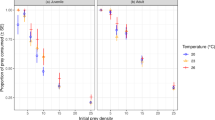Abstract
Predicting the ecological impacts of invasive species is impeded by context-dependencies that can mediate the strength of trophic interactions. Reproductive status is a pervasive context across trophic and taxonomic groups, yet has mostly been neglected in studies of invader impact. The present study examines the influence of the reproductive cycle on predatory impacts of a known damaging invasive freshwater crustacean, Gammarus pulex (Amphipoda), using a comparative functional response approach. Across females that were non-ovigerous, or had immature- or mature-stage embryonic broods, all G. pulex exhibited potentially prey destabilising Type II functional responses towards chironomid larvae. Attack rates were highest by immature embryonic brood stages, and significantly lower by mature embryonic brood stages. Conversely, handling times were consistently lower, and hence maximum feeding rates higher, where broods were present as compared to absent. These predatory patterns may reflect changing resource demands for progeny development across the reproductive cycle, the influence of brood bulk, female moult stage and/or motivational aspects of feeding, such as avoidance of filial cannibalism. Accordingly, many aspects of reproduction may alter the intensity of predatory impacts by invasive species. Future studies considering invader impacts should consider the influence of sex and reproductive status to more holistically quantify and predict population-level invader impacts.


Similar content being viewed by others
References
Bellard C, Cassey P, Blackburn TM (2016) Alien species as a driver of recent extinctions. Biol Lett 12:20150623
Boets P, Laverty C, Fukuda S et al (2019) Intra-and intercontinental variation in the functional responses of a high impact alien invasive fish. Biol Invasions 21:1751–1762
Bolker BM (2010) bbmle: Tools for general maximum likelihood estimation. R package. www.cran.rproject.org. Accessed 5 Mar 2019
Conlan KE (1991) Precopulatory mating behavior and sexual dimorphism in the amphipod Crustacea. In: VIIth international colloquium on Amphipoda. Springer, Dordrecht, pp 255–282
Cuthbert RN, Dalu T, Wasserman RJ, Weyl OL, Callaghan A, Froneman W, Dick JT (2019) Sex-skewed trophic impacts in ephemeral wetlands. Freshw Biol 64:359–366
Cuthbert RN, Kotronaki SG, Dick JT, Briski E (2020) Salinity tolerance and geographical origin predict global alien amphipod invasions. Biol Lett 16:20200354
Dick JT (2008) Role of behaviour in biological invasions and species distributions; lessons from interactions between the invasive Gammarus pulex and the native G. duebeni (Crustacea: Amphipoda). Contrib Zool 77:91–98
Dick JT, Platvoet D (2000) Invading predatory crustacean Dikerogammarus villosus eliminates both native and exotic species. P Roy Soc B Biol Sci 267:977–983
Dick JT, Faloon SE, Elwood RW (1998) Active brood care in an amphipod: influences of embryonic development, temperature and oxygen. Anim Behav 56:663–672
Dick JT, Alexander ME, Jeschke JM et al (2014) Advancing impact prediction and hypothesis testing in invasion ecology using a comparative functional response approach. Biol Invasions 16:735–753
Dick JT, Laverty C, Lennon JJ et al (2017) Invader relative impact potential: a new metric to understand and predict the ecological impacts of existing, emerging and future invasive alien species. J Appl Ecol 54:1259–1267
Dickey JW, Cuthbert RN, South J et al (2020) On the RIP: using relative impact potential to assess the ecological impacts of invasive alien species. NeoBiota 55:27–60
Elton CS (2020) The ecology of invasions by animals and plants. Springer, Berlin
Elwood RW, Dick JTA (1989) Assessments and decisions during mate choice in Gammarus pulex (Amphipoda). Behaviour 109:235–246
Grabowski M, Bacela K, Konopacka A (2007) How to be an invasive gammarid (Amphipoda: Gammaroidea)—comparison of life history traits. Hydrobiologia 590:75–84
Holling CS (1959) Some characteristics of simple types of predation and parasitism. Can Entomol 91:385–398
Hynes H (1955) The reproductive cycle of some British freshwater Gammaridae. J Anim Ecol 24:352–387
Juliano SA (2001) Nonlinear curve fitting: predation and functional response curves. Des Anal Ecol Exp 2:178–196
Lardies MA, Cotoras IS, Bozinovic F (2004) The energetics of reproduction and parental care in the terrestrial isopod Porcellio laevis. J Insect Physiol 50:1127–1135
Laverty C, Dick JT, Alexander ME, Lucy FE (2015) Differential ecological impacts of invader and native predatory freshwater amphipods under environmental change are revealed by comparative functional responses. Biol Invasions 17:1761–1770
Laverty C, Green KD, Dick JT et al (2017) Assessing the ecological impacts of invasive species based on their functional responses and abundances. Biol Invasions 19:1653–1665
Lewis SE, Dick JT, Lagerstrom EK, Clarke HC (2010) Avoidance of filial cannibalism in the amphipod Gammarus pulex. Ethology 116:138–146
Pritchard DW, Paterson RA, Bovy HC, Barrios-O’Neill D (2017) Frair: an R package for fitting and comparing consumer functional responses. Methods Ecol Evol 8:1528–1534
Rogers D (1972) Random search and insect population models. J Anim Ecol 41:369–383
Sutcliffe DW (1992) Reproduction in Gammarus (Crustacea, Amphipoda): basic processes. Freshw Forum 2:102–128
Acknowledgements
Authors acknowledge the funding agencies, Department of Biotechnology, India (F. No. BT/IN/UK/DBT-BC/2015-16) and British Council, UK (Application No. 228107673) for the programme ‘Newton-Bhabha Ph.D. placement programme’ awarded to AD. RC acknowledges funding from the Alexander von Humboldt Foundation.
Author information
Authors and Affiliations
Corresponding author
Ethics declarations
Conflict of interest
The authors declare that there is no conflict of interest.
Additional information
Publisher's Note
Springer Nature remains neutral with regard to jurisdictional claims in published maps and institutional affiliations.
Rights and permissions
About this article
Cite this article
Dalal, A., Gallogly, J., Cuthbert, R.N. et al. Ecological impacts of an invasive predator are mediated by the reproductive cycle. Biol Invasions 23, 669–675 (2021). https://doi.org/10.1007/s10530-020-02414-2
Received:
Accepted:
Published:
Issue Date:
DOI: https://doi.org/10.1007/s10530-020-02414-2




